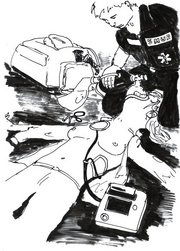Defibrillation
|
|
Defibrillation is a medical technique used to counter the onset of ventricular fibrillation, a common cause of cardiac arrest, and ventricular tachycardia, which sometimes precedes ventricular fibrillation but can be just as dangerous on its own. The equipment used in this process is called a defibrillator. Defibrillation is part of advanced cardiac life support.
| Contents |
Uses
Defibrillation is a technique used in emergency medicine to terminate ventricular fibrillation. It uses an electrical shock to reset the electrical state of the heart so that it may beat to a rhythm controlled by its own natural pacemaker cells. The most common indications for emergency defibrillation is for ventricular fibrillation and ventricular tachycardia. It is not effective for asystole (complete cessation of cardiac activity).
Often, ventricular fibrillation is preceded by ventricular tachycardia. While these are both fast rhythms in the lower chambers of the heart (the left and right ventricles), ventricular tachycardia is a more organized rhythm which usually still gives marginal cardiac output, while ventricular fibrillation is described as chaotic activity of the ventricles. While ventricular tachycardia can lead to ventricular fibrillation, it is often self-limiting. Ventricular fibrillation never converts to sinus rhythm, and will always lead to death if it is not terminated quickly. Ventricular tachycardia may be associated with an adequate blood pressure to perfuse the brain. Often, however, the heart is beating too fast for blood to enter the heart, causing a low blood pressure and decreased perfusion of the brain and other vital organs. In ventricular fibrillation, since the electrical activity in the ventricle is chaotic, there's no organized pumping of blood, and therefore there is no blood perfusion of the brain.
The purpose of defibrillation of ventricular arrhythmias is to apply a controlled electrical shock to the heart, which leads to depolarization of the entire electrical conduction system of the heart. When the heart repolarizes, the normal electrical conduction may assert itself, in which case the ventricular arrhythmia is terminated. However, if enough energy is not used for defibrillation, the heart may not be completely depolarized, in which case the ventricular tachycardia or fibrillation may not be terminated. Also, if the heart itself is not getting enough oxygen or if there is an instability of the electrolytes in the cardiac cells, the ventricular arrhythmia may recur.
If there is no electrical activity in the heart (electrical asystole, or standstill), then the heart is already depolarized, and defibrillation will have no effect. Similarly, pulseless electrical activity (the remaining cause of cardiac arrest) features normal electrical activity without adequate myocardial contraction or cardiac output, in which defibrillation would be of no use.
Although the process of defibrillation can be repeated, the number of attempts is, in practice, limited, to a series of three or four attempts at increasing voltages, as the likelihood of restoring normal heart rhythm is much less in successive attempts.
Increasingly, automated external defibrillators (AEDs) are being made available at airports, shopping centres, etc.
Defibrillators can also be implanted (implantable cardioverter-defibrillators or ICDs) in people at high risk of developing an arrhythmia. The ICD is rather like an artificial pacemaker, and indeed performs all the functions of a pacemaker, but it can also deliver a defibrillation shock if a dangerous arrhythmia is detected.
History
Defibrillation was invented in 1899 by Prevost and Batelli, two Italian physiologists. They discovered that electric shocks could convert ventricular fibrillation to sinus rhythm in dogs. The first case of a human life saved by defibrillation was reported by Beck et al in 1947.
A major breakthrough was the introduction of portable defibrillators in ambulances in the 1960s. This was pioneered by Prof. Frank Pantridge in Belfast.
See also
References
- Prevost JL, Battelli F. La mort par les déscharges électriques (French: "Death by electrical discharges". J. Physiol 1899;1:1085-1100.
- Beck CS, Pritchard WH, Feil HS. Ventricular fibrillation of long duration abolished by electric shock. J Amer Med Assoc 1947;135:985.
External link
- History of defibrillation (http://efimov.wustl.edu/defibrillation/history/defibrillation_history.htm)de:Defibrillation

